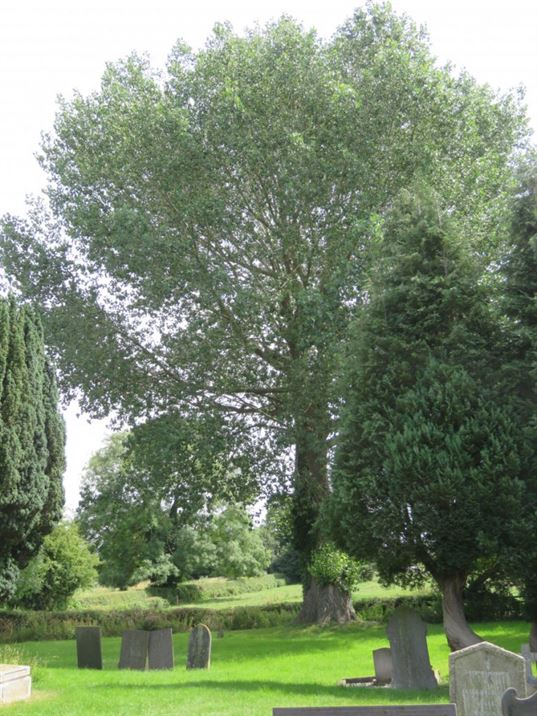(Article No.2 by Carol Beadle)
NO 2
HICKLING CHURCHYARD – MORE THAN JUST GRAVESTONES
In Hickling Churchyard is a section of ground where there is no evidence of graves and this area has been a clear grassed area with no plants or trees as long as people can remember. There are no official records to explain why and unlike many churches, Hickling Church Records do not contain a map of early burials in the churchyard.

Earlier Guide Books for Hickling Church have reported that this area was the ‘cholera pit’ where people who died during the cholera outbreaks were laid to rest quickly in a mass grave. However, the Parish Records for Hickling do not record many deaths during the major cholera outbreaks in the 1700’s and 1800’s, to warrant such a mass grave, so perhaps this is not true.
However, evidence does all seem to point to the fact that this area was where several bodies were buried together. Disposal of the bodies of those who died in the major epidemics of the early modern period undoubtedly presented huge problems.
The Hickling Parish Records and Bishop’s Transcripts records the names of residents who were buried in the churchyard at Hickling. The Parish Records start in 1621 with the earlier documents difficult to read After 1646 the records appear more complete but with gaps during the Civil War period. There are no periods in the existing Parish Registers which show large numbers of people dying within a short period. Therefore, if this area was the site of a mass grave it is likely to have been dug in the early 1600’s
It is now believed this area was in fact a ‘plague pit’ A plague pit is the informal term used to refer to mass graves in which victims of the Black Death – thought to be a combination of bubonic, pneumonia and perhaps septicaemic plague, which swept across the country in the early part of the 1600’s. The plague of the 1660’s in London and the large number of mass graves within the City are well researched and documented. Parishes throughout the country were faced with a similar problem of how to dispose of their dead quickly.
At this period an individual grave was standard, though two or three individuals might share a grave. Traditional funeral practises and internment in which family and friends played an important role in their desire for commemoration came into conflict with the Parish Officers who would have to cope as best as they could with the pressures of burying bodies as quickly as possible. Large pits for communal burials became a critical necessity when the Parish needed a quick burial space for the victims of the plague. The ground was often treated with quicklime and there was generally an understanding that these grave pits should not be disturbed.
The stories of where these ‘plague pits’ were situated in the churchyard was passed down the generations [perhaps with a little embellishment] even though there may be no official documentation. This may be just what has happened in Hickling.
There is further proof that the story may be true. Plague was rife in the area around Hickling in the early 1600’s. Existing records seem to indicate that an epidemic of the plague affected one village at a time. In 1609 many hundreds of people died of the plague in the city of Nottingham. The city continued to have outbreaks of the plague during the first half of the 1600’s. In fact, Goose Fair was cancelled in 1646 for fear of it encouraging the further spreading of the plague.
Cotgrave, which is not too far from Hickling had outbreaks of the plague in 1616 and 1626 but in the year 1637, the largest one happened between April and September of that year. 93 people out of probably a village with only 450 people died that year of the plague. Colston Bassett records show the plague in the village in 1623 and 83 people dying. The plague reached East Stoke in 1640. Stathern also had to deal with the plague in the early 1600’s with the Hacker family of Stathern Hall losing a child to the plague.
It is also thought that during the Civil War the Parliamentarian soldiers carried the plague from place to place and the Newark outbreaks have been credited to them. A Parliamentarian soldier who was killed in battle at Newark was taken to his home village of Collingham to be buried and a few days later this village had an outbreak of the plague.
Therefore, it can be assumed that the plague may have reached Hickling at some point between 1610 and 1646.
Some of the wealthier families living in Hickling during the late 1500’s left documents which has enabled researchers to understand how the village operated and who lived here. In the late 1500’s, Thomas Noble resided in Hickling and had a large family. He had a least 5 sons, Nicholas, Oliver, John, William, and Edward. who would have been Thomas’s heirs and would have had families of their own. This complete family disappear from all records and while it could be expected that one or two of the sons moved away, the whole family would not have done so. Other old Hickling family names also disappear at this time including the Hopkinsons and the Hewitts. Were they victims of the plague?
One other theory put forward is that soldiers killed in the Hickling area during the Civil War were buried together in a large pit in the Churchyard. There would certainly have been casualties in and around Hickling and these would not have been recorded in the Church Records.
Perhaps in the future more information about this ‘plague pit’ will be discovered but at the moment it is another interesting feature of Hickling Churchyard.
